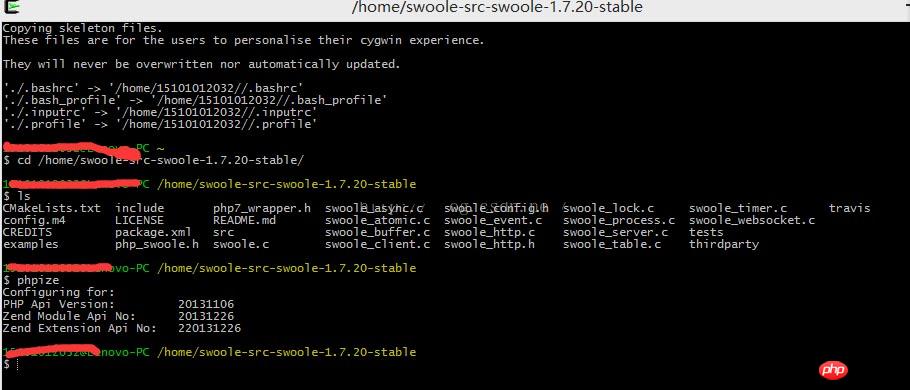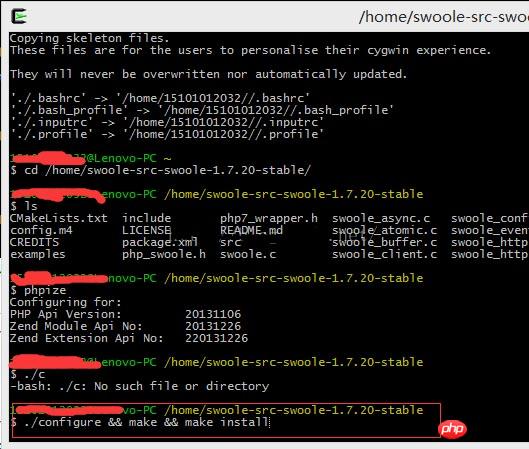 Backend Development
Backend Development
 PHP Tutorial
PHP Tutorial
 Graphical tutorial on installing swoole under Windows (step-by-step explanation)
Graphical tutorial on installing swoole under Windows (step-by-step explanation)
Graphical tutorial on installing swoole under Windows (step-by-step explanation)
The following editor will bring you a graphic tutorial (php) on installing swoole under Windows. The editor thinks it is quite good, so I will share it with you now and give it as a reference for everyone. Let’s follow the editor and take a look.
Specific steps to install swoole under Windows:
Swoole is not originally supported for installation under Windows. So we need to install Cygwin to use it. I encountered a lot of pitfalls when installing Cygwin, and the documentation on Baidu's experience is not very complete, so I wrote down my own installation of Cygwin and Swoole, which is equivalent to my own precipitation.
First prepare the tools:
Cygwin official address: http://www.cygwin.com/
swoole official Download address: https://github.com/swoole/swoole-src/releases
1. Download Swoole and Cygwin

Download Cygwin, mine is 64-bit

##1 Install Cygwin



 ##Finally autoconf
##Finally autoconf
 Finally, just go to the next step to install it.
Finally, just go to the next step to install it.

2 Install SwooleExtract the source program of swoole to the Cygwin home directory and open the Cygwin software (Note: If your Cygwin is also installed on the C drive, then you have to pay attention. An error may be reported when installing swoole. The solution is to right-click and open Cygwin as administrator)
 1 The environment at this time is like a Linux terminal, and the root directory is the Cygwin installation directory. Enter the command in the interface: cd /home/swoole-src, where swool-src is the decompressed source program
1 The environment at this time is like a Linux terminal, and the root directory is the Cygwin installation directory. Enter the command in the interface: cd /home/swoole-src, where swool-src is the decompressed source program
 2 The environment at this time is like a Linux terminal, and the root directory is the Cygwin installation directory. Enter the command in the interface: cd /home/swoole-src, where swool-src is the decompression source. Program
2 The environment at this time is like a Linux terminal, and the root directory is the Cygwin installation directory. Enter the command in the interface: cd /home/swoole-src, where swool-src is the decompression source. Program
 3 Enter the command: phpize to generate the compiled configuration file configure
3 Enter the command: phpize to generate the compiled configuration file configure
 4 Enter the command: ./configure && make && make install
4 Enter the command: ./configure && make && make install

Configure, compile, compile and install swoole
(PS: execute ./configure, In addition to compiling the configuration, the environment will also be detected, etc.)
5Use the command: php -i | grep php.ini, find the path to the configuration file php.ini used by php cli, modify the php.ini file, and Add a line to the file: extension=swoole.so, then close and exit
 6 /extension search press n to search again
6 /extension search press n to search again
 7 Add extension=swoole.so
7 Add extension=swoole.so
 8 :wq Save and exit
8 :wq Save and exit
9 Use command: php -m to view the loaded module. If you see to swoole, the extension is added successfully, and the environment is successfully built!
The above is the detailed content of Graphical tutorial on installing swoole under Windows (step-by-step explanation). For more information, please follow other related articles on the PHP Chinese website!

Hot AI Tools

Undresser.AI Undress
AI-powered app for creating realistic nude photos

AI Clothes Remover
Online AI tool for removing clothes from photos.

Undress AI Tool
Undress images for free

Clothoff.io
AI clothes remover

AI Hentai Generator
Generate AI Hentai for free.

Hot Article

Hot Tools

Notepad++7.3.1
Easy-to-use and free code editor

SublimeText3 Chinese version
Chinese version, very easy to use

Zend Studio 13.0.1
Powerful PHP integrated development environment

Dreamweaver CS6
Visual web development tools

SublimeText3 Mac version
God-level code editing software (SublimeText3)

Hot Topics
 1378
1378
 52
52
 PHP 8.4 Installation and Upgrade guide for Ubuntu and Debian
Dec 24, 2024 pm 04:42 PM
PHP 8.4 Installation and Upgrade guide for Ubuntu and Debian
Dec 24, 2024 pm 04:42 PM
PHP 8.4 brings several new features, security improvements, and performance improvements with healthy amounts of feature deprecations and removals. This guide explains how to install PHP 8.4 or upgrade to PHP 8.4 on Ubuntu, Debian, or their derivati
 How To Set Up Visual Studio Code (VS Code) for PHP Development
Dec 20, 2024 am 11:31 AM
How To Set Up Visual Studio Code (VS Code) for PHP Development
Dec 20, 2024 am 11:31 AM
Visual Studio Code, also known as VS Code, is a free source code editor — or integrated development environment (IDE) — available for all major operating systems. With a large collection of extensions for many programming languages, VS Code can be c
 7 PHP Functions I Regret I Didn't Know Before
Nov 13, 2024 am 09:42 AM
7 PHP Functions I Regret I Didn't Know Before
Nov 13, 2024 am 09:42 AM
If you are an experienced PHP developer, you might have the feeling that you’ve been there and done that already.You have developed a significant number of applications, debugged millions of lines of code, and tweaked a bunch of scripts to achieve op
 How do you parse and process HTML/XML in PHP?
Feb 07, 2025 am 11:57 AM
How do you parse and process HTML/XML in PHP?
Feb 07, 2025 am 11:57 AM
This tutorial demonstrates how to efficiently process XML documents using PHP. XML (eXtensible Markup Language) is a versatile text-based markup language designed for both human readability and machine parsing. It's commonly used for data storage an
 Explain JSON Web Tokens (JWT) and their use case in PHP APIs.
Apr 05, 2025 am 12:04 AM
Explain JSON Web Tokens (JWT) and their use case in PHP APIs.
Apr 05, 2025 am 12:04 AM
JWT is an open standard based on JSON, used to securely transmit information between parties, mainly for identity authentication and information exchange. 1. JWT consists of three parts: Header, Payload and Signature. 2. The working principle of JWT includes three steps: generating JWT, verifying JWT and parsing Payload. 3. When using JWT for authentication in PHP, JWT can be generated and verified, and user role and permission information can be included in advanced usage. 4. Common errors include signature verification failure, token expiration, and payload oversized. Debugging skills include using debugging tools and logging. 5. Performance optimization and best practices include using appropriate signature algorithms, setting validity periods reasonably,
 PHP Program to Count Vowels in a String
Feb 07, 2025 pm 12:12 PM
PHP Program to Count Vowels in a String
Feb 07, 2025 pm 12:12 PM
A string is a sequence of characters, including letters, numbers, and symbols. This tutorial will learn how to calculate the number of vowels in a given string in PHP using different methods. The vowels in English are a, e, i, o, u, and they can be uppercase or lowercase. What is a vowel? Vowels are alphabetic characters that represent a specific pronunciation. There are five vowels in English, including uppercase and lowercase: a, e, i, o, u Example 1 Input: String = "Tutorialspoint" Output: 6 explain The vowels in the string "Tutorialspoint" are u, o, i, a, o, i. There are 6 yuan in total
 Explain late static binding in PHP (static::).
Apr 03, 2025 am 12:04 AM
Explain late static binding in PHP (static::).
Apr 03, 2025 am 12:04 AM
Static binding (static::) implements late static binding (LSB) in PHP, allowing calling classes to be referenced in static contexts rather than defining classes. 1) The parsing process is performed at runtime, 2) Look up the call class in the inheritance relationship, 3) It may bring performance overhead.
 What are PHP magic methods (__construct, __destruct, __call, __get, __set, etc.) and provide use cases?
Apr 03, 2025 am 12:03 AM
What are PHP magic methods (__construct, __destruct, __call, __get, __set, etc.) and provide use cases?
Apr 03, 2025 am 12:03 AM
What are the magic methods of PHP? PHP's magic methods include: 1.\_\_construct, used to initialize objects; 2.\_\_destruct, used to clean up resources; 3.\_\_call, handle non-existent method calls; 4.\_\_get, implement dynamic attribute access; 5.\_\_set, implement dynamic attribute settings. These methods are automatically called in certain situations, improving code flexibility and efficiency.



